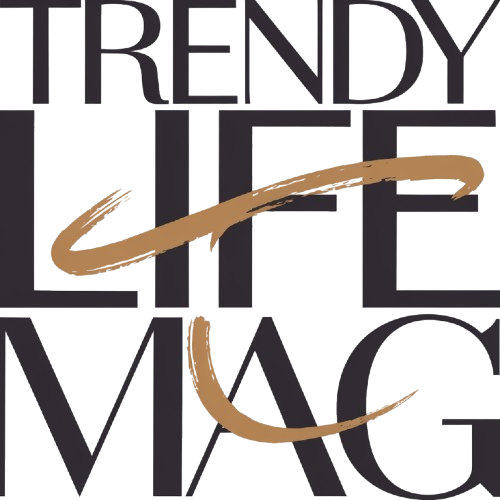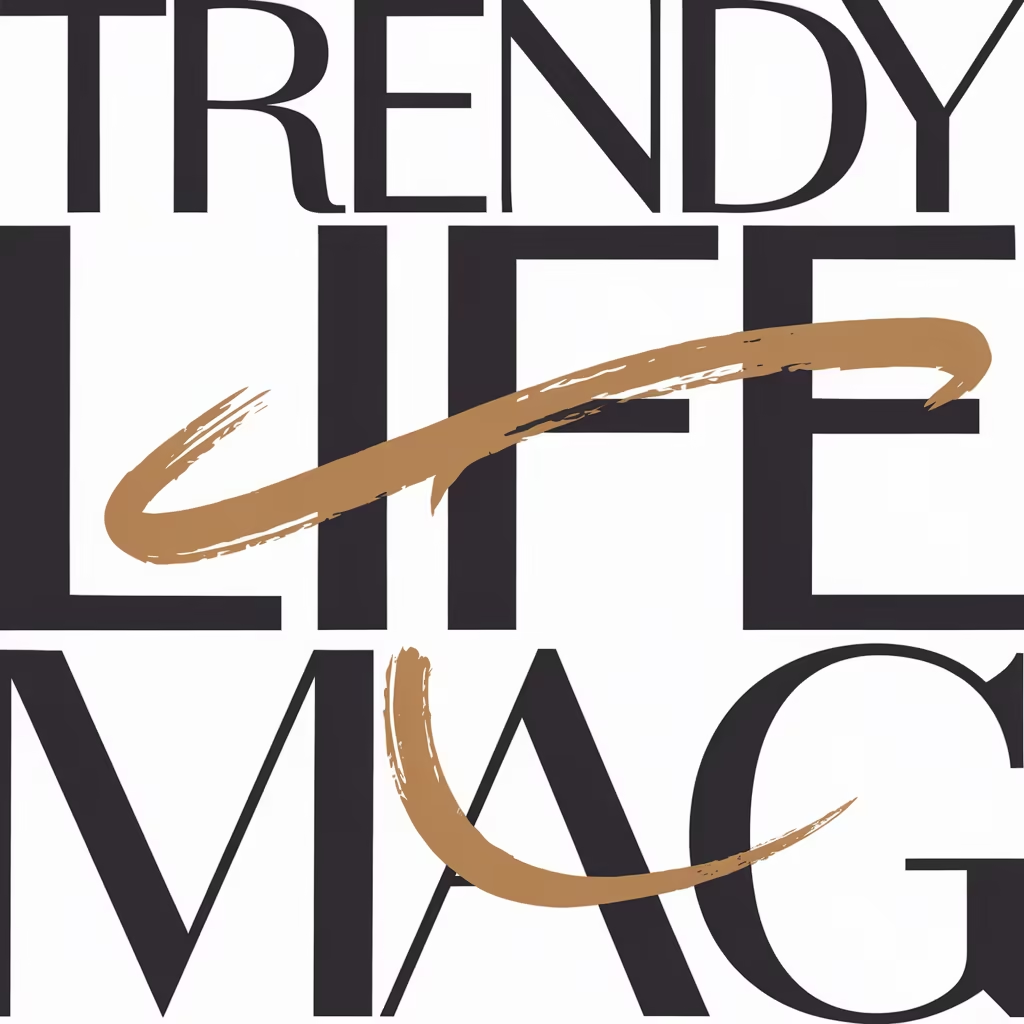Table of Contents
The 1930s brought major changes to how people dressed and thought about fashion. As the Great Depression hit homes across the world, it sparked creative ways to stay stylish with less money. Looking at 1930s fashion trends shows us how people adapted their style during tough times.
What were the fashion trends in the 1930s? The answer reveals a fascinating mix of practicality and dreams of glamour. As money got tight, people learned to make clothes last longer and create new styles from old materials. Women moved away from the loose, flapper dresses of the 1920s. Instead, they chose fitted styles that followed natural body lines and used less fabric.
Movie stars like Greta Garbo and Jean Harlow inspired how women wanted to look. Even with limited money, people found ways to copy Hollywood glamour at home. They made elegant dresses from simple materials and turned basic outfits into something special with clever details.
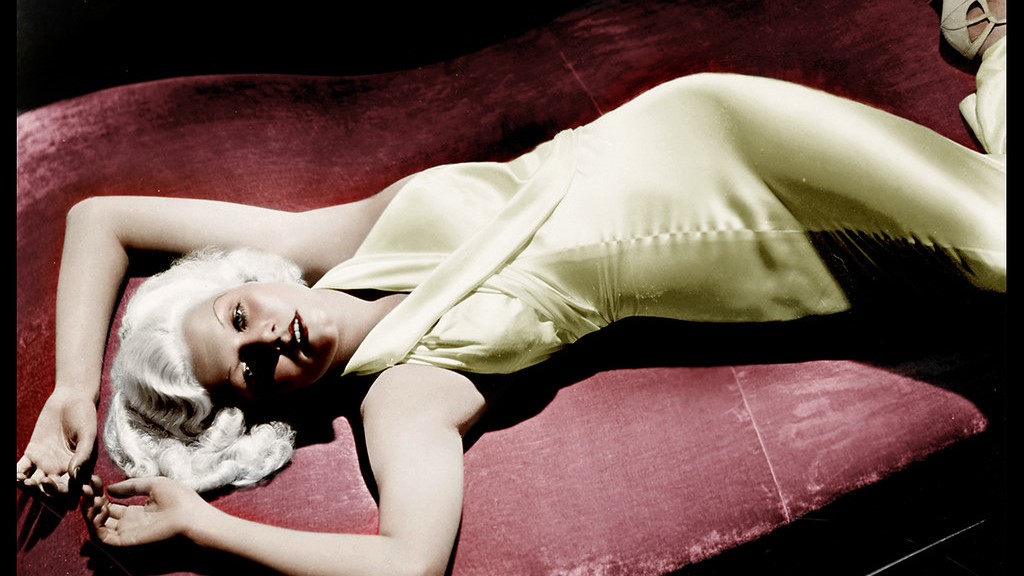
These style lessons from the 1930s still matter today, especially when we think about fashion on a budget and making clothes last longer. Stay tuned as we are going to take a look at 1930 fashion trends and answer all of your questions.
When Evening Glamour Made a Comeback
Despite hard times during the day, nights in the 1930s sparkled with style. After the simple, straight dresses of the 1920s, evening glamour returned in a big way. Women wanted to look like movie stars, and their evening wear showed it.
Among the most loved iconic 1930s clothing pieces were long, flowing evening gowns. These dresses hugged the body from shoulder to hip, then spread out into beautiful skirts that touched the floor. Backs were often left bare, adding drama when women walked into a room.
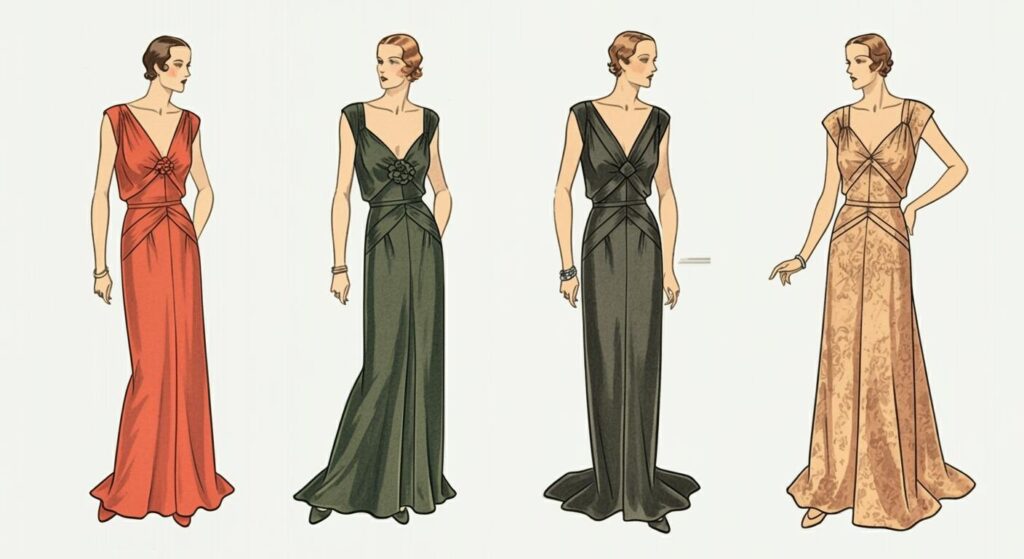
Materials That Caught the Light
Evening wear sparkled even during tough times. Women chose silk in rich colors like deep red and royal blue for special nights out. Shiny satin became popular because it caught the light and created movement. In winter, soft velvet added warmth and luxury. For extra shine, dresses often featured small details like beads and sequins.
Designers knew how to make every dress special. They added low-cut backs that drew attention when women turned around. Thin straps over shoulders showed off arms gracefully. Careful pleats and folds gave simple fabrics an expensive look. Small belts showed off tiny waists, creating that classic 1930s shape.
Movie stars like Jean Harlow and Greta Garbo showed women how to wear these styles. While not everyone could afford real silk or diamonds, clever women found ways to copy these looks using less expensive materials. They proved that true glamour wasn’t about money – it was about style.
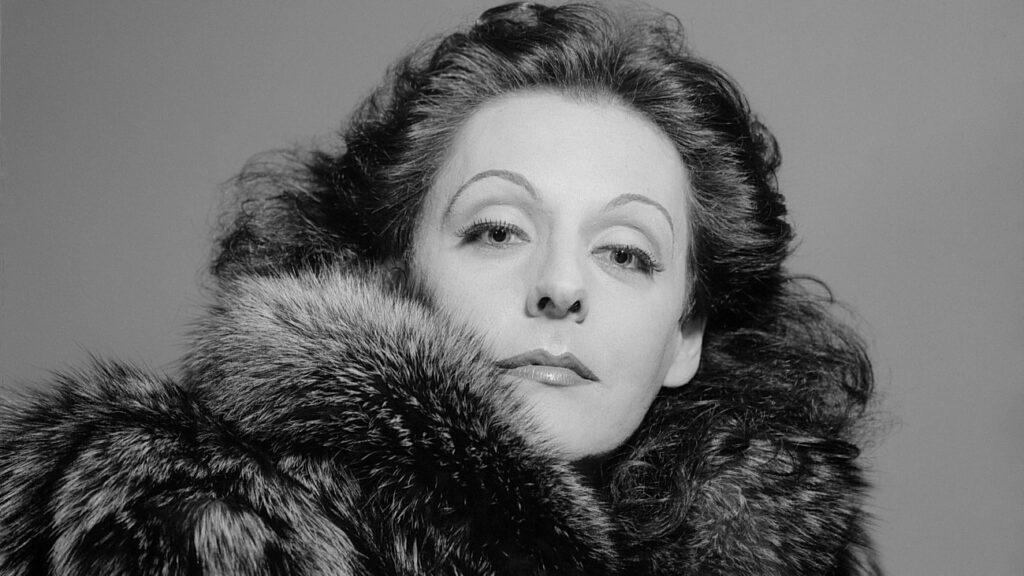
Making Do and Looking Good: How Hard Times Changed Fashion
The Great Depression changed more than just the economy – it transformed how people thought about clothes. When money became scarce, people had to rethink their whole approach to fashion. This led to some of the most creative fashion trends in the 1930s.
Women became masters at making clothes last longer. They turned dresses inside out when one side wore thin. Skirts and dresses were made longer or shorter to match changing styles. When clothes couldn’t be fixed anymore, they became cleaning rags or quilt pieces. Nothing went to waste.
New Ways with Fabric
Cotton became the everyday choice because it was cheap and strong. Women saved fancy materials like silk for special occasions.
Feed sacks became popular for making clothes – so popular that feed companies started printing their sacks with pretty patterns. Flour companies did the same, knowing their sacks would become dresses and shirts.
The Rise of Home Sewing
More women learned to sew at home. They made new clothes from old ones and copied expensive styles using cheaper materials. Pattern companies created designs that used less fabric but still looked stylish. Women shared patterns and sewing tips with friends and family, turning necessity into a social activity.
These changes showed that style didn’t need to cost much. People learned to be creative and resourceful while staying fashionable.
The Shape of Style: 1930s Fashion Lines
The iconic silhouettes of the 1930s marked a clear shift from the boxy shapes of the 1920s. These new styles celebrated natural body lines while keeping things practical and elegant.
Womens Shapes
Womens fashion took a dramatic turn toward showing natural curves. Dresses now fit close to the body, with waistlines returning to their natural place. The popular bias-cut technique made dresses that seemed to flow like water, following the body’s shape without clinging too tightly. Skirts fell to mid-calf and flared gently, creating a graceful look when walking.
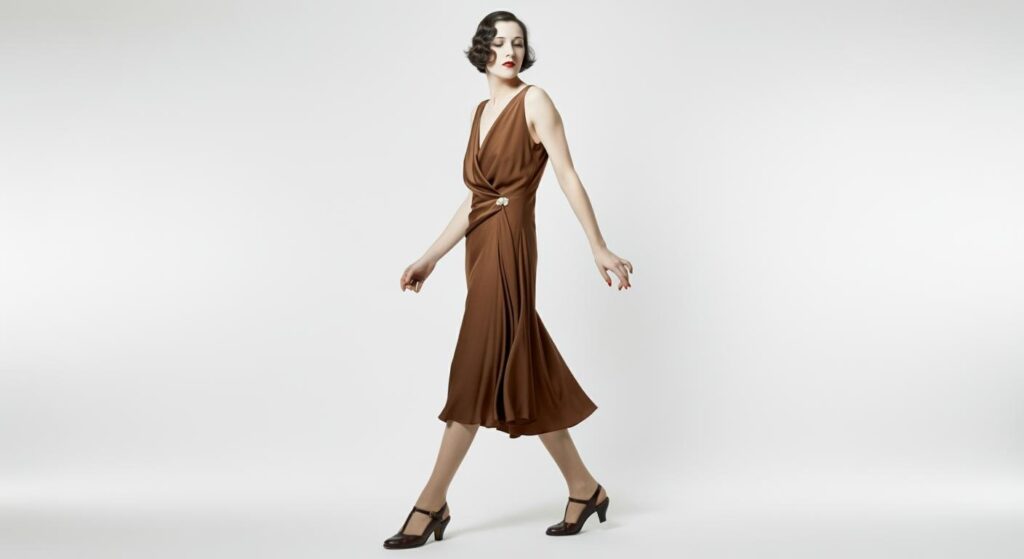
Men’s Classic Lines
Men’s fashion became more relaxed but kept its polish. Suits featured broader shoulders and a trimmer waist, creating a strong, athletic look. Pants sat high on the waist and fell straight to the ankle. This style made men look taller and more powerful, even during tough times.
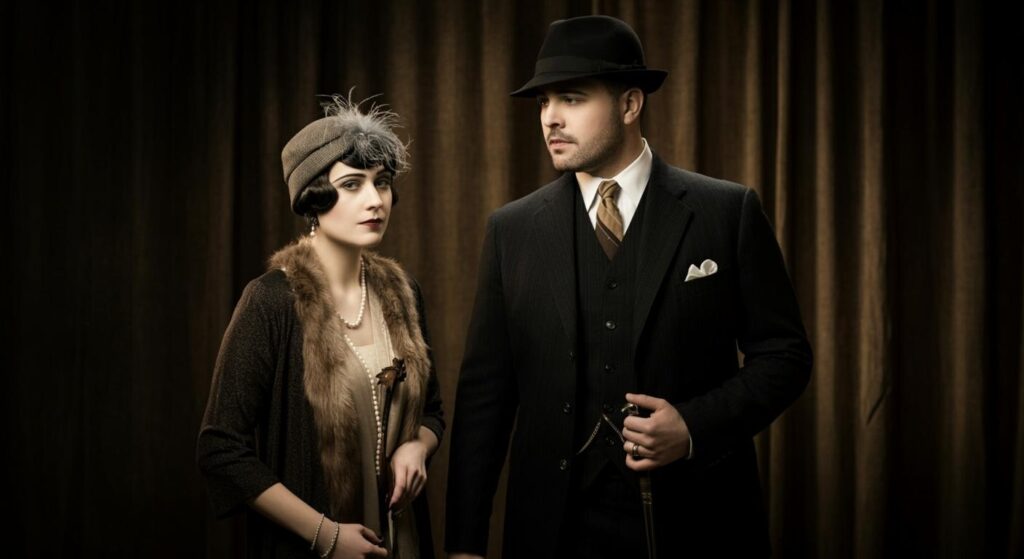
Key Features of 1930s Shapes
For women, necklines became more interesting, with soft drapes and subtle details. Shoulders stayed natural but began showing subtle padding.
Evening dresses often featured low backs rather than low fronts, adding drama without being too showy. For men, double-breasted suits became popular, with wide lapels and plenty of room in the chest.
These shapes didn’t just look good – they worked well for everyday life. The styles were comfortable enough for work but still looked put-together for social occasions. This blend of comfort and style made these shapes popular throughout the decade.
Materials That Made the Style: 1930s Fabrics
The fabrics used in 1930s fashion showed how creative people could be during hard times. New materials changed what was possible in clothing design, leading to fresh looks that shaped what were the fashion trends in the 1930s.
The Rise of Rayon
Rayon became the decades star fabric. Looking like silk but costing much less, it helped bring lovely clothes to more people.
This new material could be made into light summer dresses or heavier winter clothes. It took dye well, letting designers create bright colors and pretty patterns.
Silk and Its Alternatives
Real silk stayed popular for special occasions, but its high price meant most people saved it for their best outfits. Clever makers found ways to blend silk with other materials, creating fabrics that looked expensive but cost less. These blends helped bring high fashion to everyday people.
Practical Choices for Daily Wear
Cotton remained the most common choice for everyday clothes. It was strong, easy to wash, and affordable. Wool kept its place in winter wardrobes, especially for suits and coats. Many women became experts at mixing different fabrics to make their wardrobes more interesting without spending too much.
These materials let designers try new things. Dresses could now drape and flow in ways impossible before. Light fabrics meant clothes could be cut on the bias, creating elegant lines that followed the body’s shape. Even simple cotton could be made into stunning outfits with the right design.
Colors That Defined an Era
The popular colors in 1930s fashion painted a picture of hope during hard times. While the decade faced challenges, the colors people wore showed their desire to stay cheerful and elegant. These shades became key fashion trends in 1930s style.
Seasons of Color
Spring brought soft pastels to life. Light pink, baby blue, and mint green reminded people of fresh starts and new beginnings. Summer saw these shades brighten into bolder versions, with coral, sky blue, and apple green taking center stage.
Fall moved into warmer earth tones. Rich browns, deep oranges, and forest greens matched the changing leaves. When winter arrived, deep jewel tones took over – ruby red, sapphire blue, and emerald green added luxury to long, dark days.
Everyday Favorites
Some colors stayed popular all year round. Navy blue became a trusted choice for both men and women. It looked good, didn’t show dirt easily, and matched almost everything. Cream and ivory offered softer alternatives to stark white, especially for blouses and summer dresses.
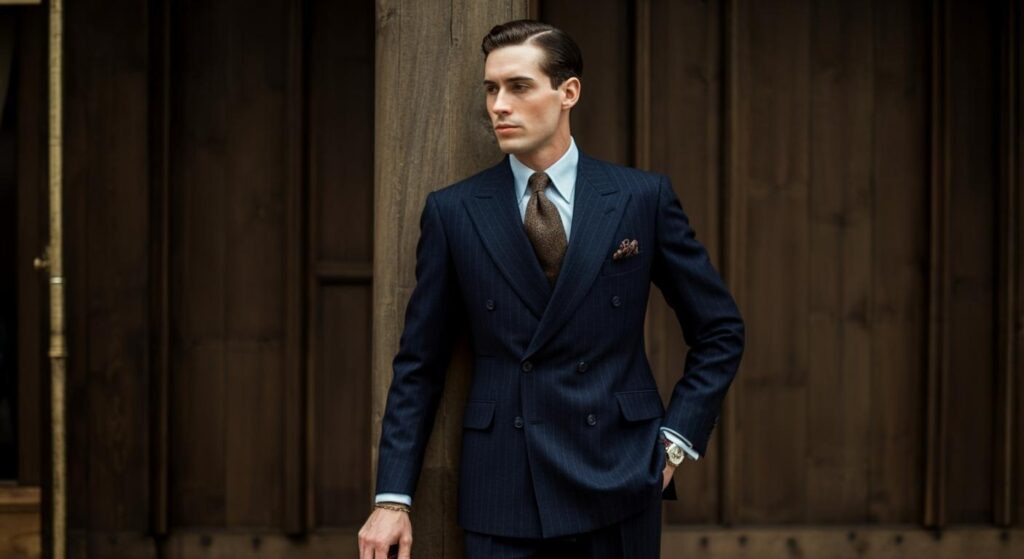
Evening Sophistication
For evening wear, black remained the king of colors, but it wasn’t alone. Silver and gold touches added sparkle to special occasions. Deep purple and wine red offered rich alternatives for those wanting to stand out at night.
These color choices helped people feel put-together and stylish, even when times were tough. Even simple clothes looked special in the right shade.
The Rise of Comfortable Style
The 1930s brought big changes in how people dressed for everyday life. Casual fashion in the 1930s made clothes more comfortable and practical than ever before. This shift showed how fashion was catching up with modern life.
Sportswear Goes Mainstream
For the first time, women could wear pants without causing a stir, especially for sports and outdoor activities. Tennis clothes, with their short skirts and light fabrics, influenced everyday wear. Beach pajamas – wide-legged jumpsuits made for the seaside – became popular for casual summer days.
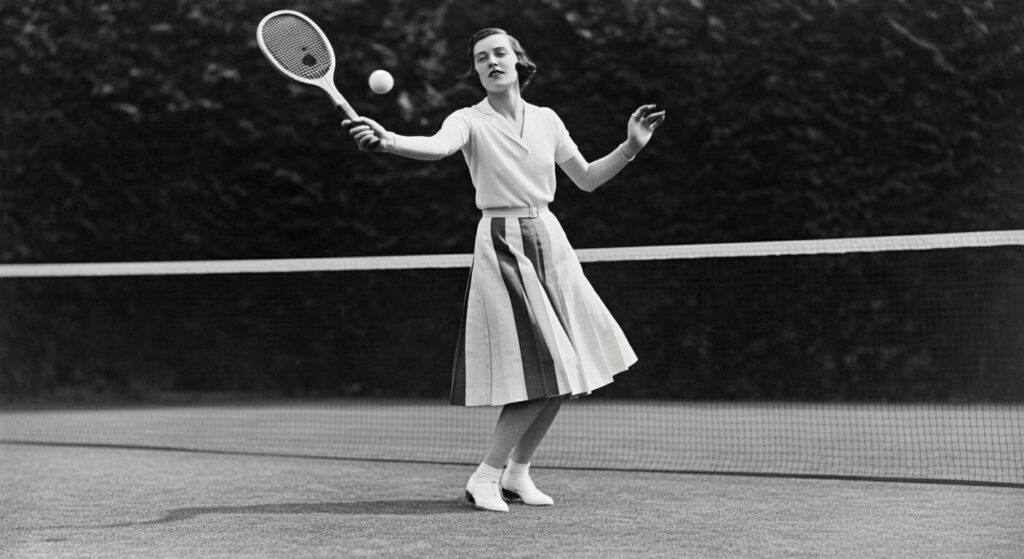
Comfort Meets Style
Sweaters became everyday favorites, worn by both men and women. They were often paired with skirts or pants for a relaxed but put-together look. Softer shoulders and looser fits made clothes easier to move in, perfect for active lives.
Weekend Wear
New styles appeared just for leisure time. Women wore divided skirts (like modern culottes) for bicycling and outdoor activities.
Men’s casual shirts replaced stiff collars for weekend wear. Even children’s clothes became more practical, with sturdy fabrics and simple designs that let them play freely.
When Hollywood Set the Style
In the 1930s, Hollywood played a major role in defining fashion trends across the world. The glamour of movie stars and their iconic clothing on-screen shaped the public’s idea of style, making film a powerful tool in setting trends.
With more people visiting theaters during this time, film stars became role models in fashion, and audiences looked to them for inspiration. As a result, the 1930s became an era where Hollywood fashion deeply influenced what people wore in daily life.
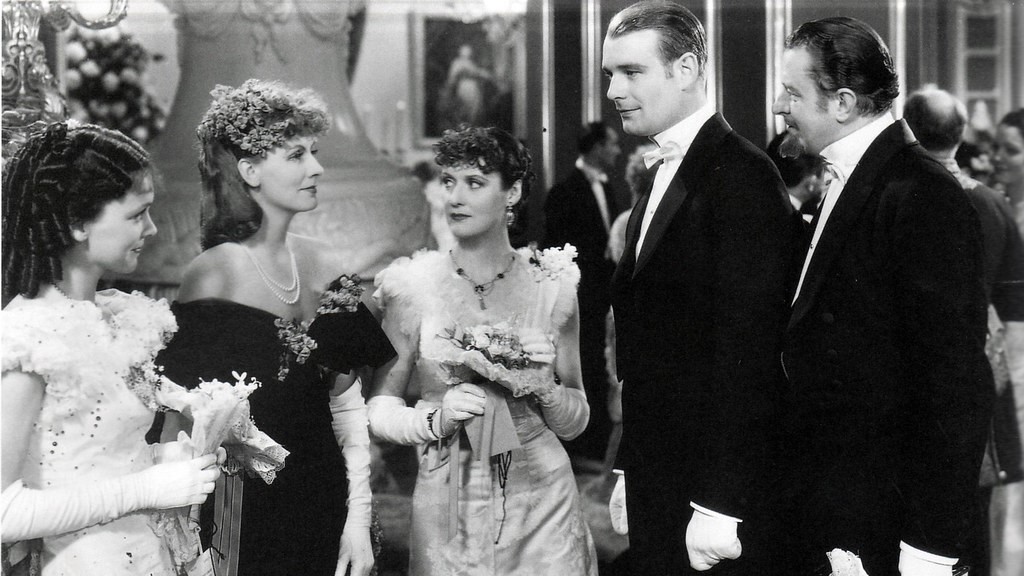
Iconic 1930s Clothing Pieces in Film
Movies during this period showcased elegant styles that emphasized sophistication and grace. Some of the most notable clothing pieces popularized by Hollywood stars included:
- Bias-cut Dresses: These dresses, often worn by stars like Jean Harlow, became a symbol of glamour. The bias cut gave dresses a draped, body-skimming look that exuded elegance and was widely imitated by women outside Hollywood.
- Wide-shouldered Jackets: Inspired by actresses like Joan Crawford, wide-shouldered jackets with a sharp silhouette made their way from the silver screen to the streets. This structured look created a bold, confident style that was new to women’s fashion.
- Satin Gowns: Hollywood’s evening wear set trends with luxurious satin gowns that shimmered on screen, capturing the public’s attention. These gowns became popular for evening events, thanks to the influence of glamorous stars such as Greta Garbo and Marlene Dietrich.
Hollywood’s Lasting Influence
Hollywood stars in the 1930s didn’t just influence what people wore; they shaped how fashion was perceived. Movie costumes became fashion statements that symbolized confidence, elegance, and modernity.
As audiences watched their favorite stars dressed in iconic pieces, they began to see Hollywood as the ultimate fashion guide. This era established a link between Hollywood and high fashion that still resonates today.
The Finishing Touches: 1930s Accessories
Accessories in 1930s fashion played a key role in completing outfits and expressing personal style.
These items added sophistication and charm to everyday looks, becoming signature pieces that defined the decade’s unique style. From hats to gloves and jewelry, accessories became essential for creating a polished look.
Key Accessories of the 1930s
- Hats: Hats were a staple for both men and women. Women’s hats often featured soft, rounded crowns or were tilted at an angle for a dramatic look. Cloche hats, which hugged the head, were still popular but evolved with added details like feathers and ribbons. Fedora hats became iconic for men, adding an air of confidence to their style.
- Gloves: Gloves were more than just practical; they were a fashion statement. Women frequently wore elbow-length gloves for formal events, while shorter gloves were common for daytime. These gloves added an elegant touch, completing both casual and formal outfits.
- Jewelry: Jewelry in the 1930s favored a mix of elegance and simplicity. Women often wore strings of pearls, modest brooches, and art deco-inspired pieces with geometric shapes. Costume jewelry, such as bracelets and necklaces with colorful stones, became affordable and stylish, allowing more people to embrace the look of luxury.
Together, these accessories defined 1930s fashion, helping people of all backgrounds add elegance and personality to their everyday attire.
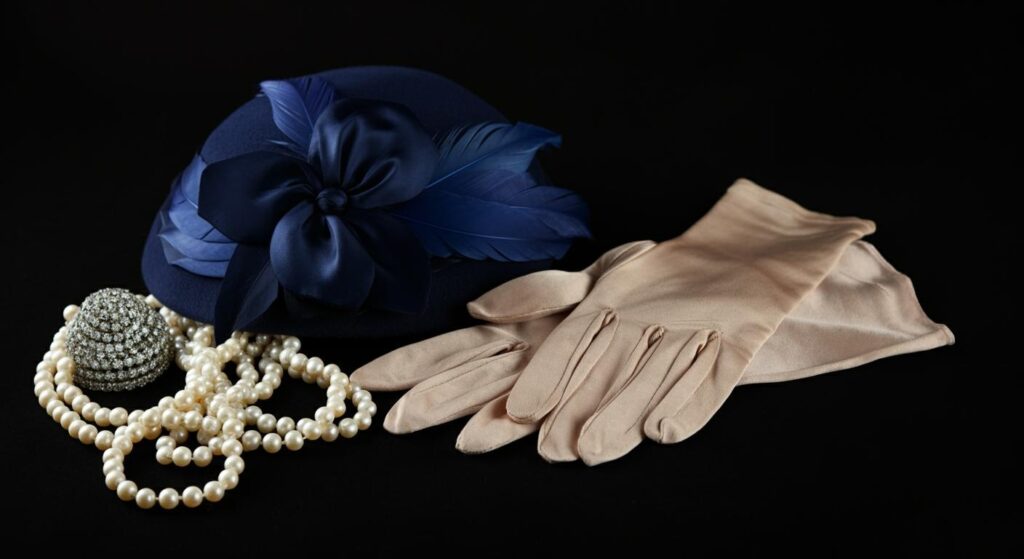
Key Trends in 1930s Men’s Fashion
The 1930s men’s fashion trends were heavily influenced by the economic conditions of the Great Depression. Despite the hardships of the time, men’s fashion maintained a sense of elegance, with practical, yet sophisticated styles defining the decade.
Key trends included tailored suits, relaxed casual wear, and work-appropriate attire, each reflecting the era’s focus on both style and function.
Tailored Suits
In the 1930s, men’s suits remained a central part of everyday fashion, and many men wore them regularly, whether for work or social events. Suits of this era had a distinct look:
- Broad Shoulders and Slim Waist: Suits often featured padded shoulders and a slimmer waistline, creating a strong, masculine silhouette.
- Double-breasted Jackets: Double-breasted jackets were especially popular, offering an extra layer of formality and class. These jackets were typically paired with wide lapels and high-waisted trousers, adding to the polished look.
- Subtle Patterns: While many suits were solid-colored, patterns such as pinstripes and checks also became popular. These subtle designs added variety without feeling overly bold.
Casual Wear
As economic conditions influenced fashion, more relaxed styles became acceptable outside formal settings. Casual attire became increasingly practical yet still maintained a sense of style:
- Sweaters and Cardigans: Men often wore sweaters over collared shirts, especially during colder months. Cardigans were popular and provided a more casual alternative to formal jackets.
- Sport Coats and Trousers: Sport coats, typically less structured and more comfortable than formal jackets, became a staple for leisure activities. Paired with trousers instead of a full suit, this look became an easy yet refined option for weekends or informal gatherings.
- Shorts and Polo Shirts: Warmer seasons saw men wearing shorts and polo shirts for the first time, especially during sporting events or at the beach. This marked a shift towards lighter, more versatile clothing.
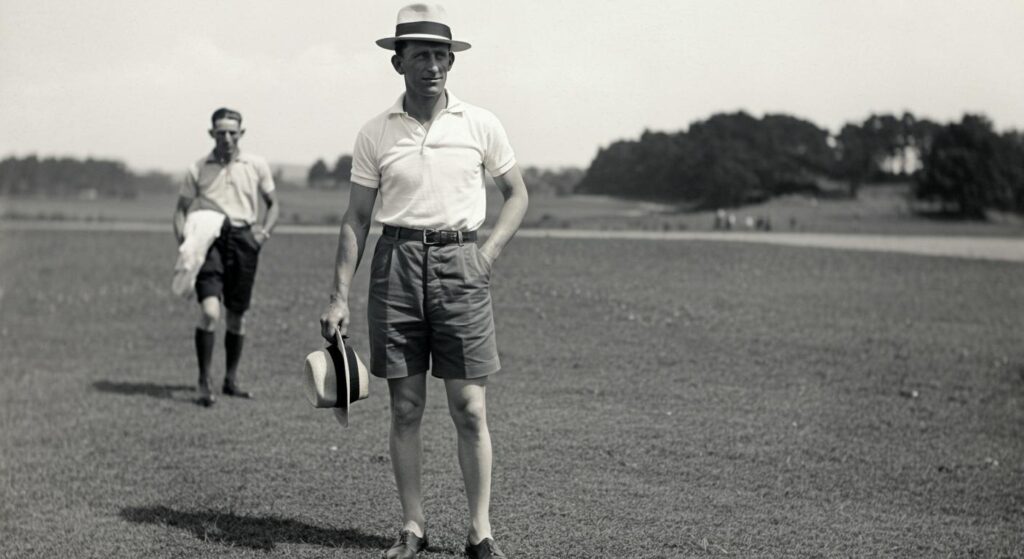
Workwear
For laborers and those working in tough environments, workwear needed to be practical and durable:
- Overalls and Coveralls: These were common among working-class men, especially for jobs requiring rugged clothing. Made of thick materials like denim, they were both affordable and long-lasting.
- Leather Jackets: Leather jackets also became popular in workwear for their durability and warmth, especially for those working outdoors.
These 1930s men’s fashion trends reflect a balance of elegance and practicality, with each piece thoughtfully designed to fit both the social climate and economic reality of the time.
The Lasting Impact of 1930s Fashion Trends
The fashion trends of the 1930s created an enduring impact, shaping styles for decades to come and reflecting the social and economic changes of the time. From the elegance of iconic 1930s clothing pieces worn by Hollywood stars to the practical, durable clothing inspired by the Great Depression, each trend left a mark on the world of fashion.
Throughout the 1930s, women’s fashion embraced bias-cut dresses, feminine silhouettes, and glamorous accessories like hats, gloves, and jewelry. These styles not only created a polished, elegant look but also empowered women to express their personal style. Meanwhile, men’s fashion emphasized well-tailored suits with broad shoulders and high-waisted trousers, along with practical casual wear that mirrored the changing lifestyles of the era.
Accessories played a significant role as well, adding the final touch to many outfits and making items like gloves and hats essential to everyday style. Together, these elements answer the question of what were the fashion trends in the 1930s, as they represent a unique blend of glamour and practicality.
The 1930s laid the groundwork for future fashion, setting trends that evolved and adapted to fit new decades, while always echoing the elegance and resilience of this memorable era.
FAQS About 1930s Fashion Trends
The 1930s was a decade of style that balanced elegance and practicality. Despite the hardships of the Great Depression, fashion continued to evolve, with trends that combined glamorous touches from Hollywood with durable, everyday styles suitable for tough economic times.
Below are answers to common questions about the key fashion trends, influences, and materials that defined 1930s style.
What were the most popular fashion trends in the 1930s?
The 1930s saw a mix of elegant and practical fashion trends. For women, bias-cut dresses that hugged the body and created a feminine silhouette were very popular, along with accessories like hats, gloves, and pearls. Men’s fashion focused on well-tailored suits with broad shoulders and slim waists, as well as casual pieces like sweaters and sport coats. Both men’s and women’s fashion often took cues from Hollywood stars, making glamour an essential part of the decade’s style.
How did the Great Depression affect fashion in the 1930s?
The Great Depression made fashion more practical and affordable. Many people looked for clothing that was durable and versatile, leading to simpler designs with less ornamentation. While elegant looks remained important, clothing styles often used cheaper materials, and accessories like gloves or hats became an easy way to add polish without significant expense. This shift helped create a balance between functional and stylish clothing that defined the era.
What were the iconic silhouettes of the 1930s?
In the 1930s, women’s silhouettes were marked by the bias cut, which created a fitted, flowing shape that hugged the body elegantly. Dresses often emphasized the waist, with soft draping around the hips, creating a balanced, hourglass figure. For men, broad-shouldered, fitted suits with slim waists and tapered trousers defined the ideal silhouette, giving a strong, confident look that was both polished and masculine.
Which fabrics and colors were popular in 1930s fashion?
Popular fabrics in the 1930s included rayon, which was affordable and draped well, as well as wool and cotton for everyday wear. Silk and satin were often used for evening wear, inspired by Hollywood’s glamorous looks. In terms of colors, neutrals like beige, navy, and gray were common, while pastel shades and muted jewel tones added variety for both men’s and women’s fashion.
How did Hollywood influence 1930s fashion?
Movie stars like Joan Crawford and Greta Garbo set major trends. People copied their hairstyles, makeup, and clothing styles. Studios released photos of stars’ wardrobes in magazines, and local seamstresses made affordable copies of movie star outfits.
